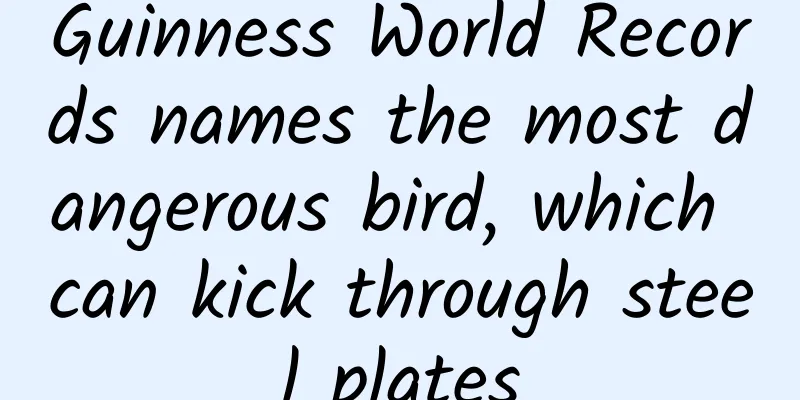Guinness World Records names the most dangerous bird, which can kick through steel plates

|
This bird can kick through a human's stomach, rip open their intestines, and even steel plates are no problem. It is the cassowary, known as the modern velociraptor, the most dangerous bird in the world. Although the cassowary is ferocious, it is not a bird of prey or a carnivorous bird. It eats fruits. Since they eat fruit, shouldn't they be docile? For example, fruit bats. Then why is the cassowary so aggressive and raises its legs high when it sees people? Such a ferocious and dangerous bird is actually very rare. Perhaps one day, we will lose this bird that is closest to dinosaurs. Dangerous Birds The cassowary is the third largest bird in the world, after the ostrich and the emu. Although these three look like free-range chickens, their personalities and temperaments are completely different. First of all, the cassowary and the ostrich are very distantly related. If you look at their feet, you can see that the ostrich has two toes, while the cassowary has three, and one of the toes has been specialized into a dagger that can grow up to 12 cm long. The cassowary is more closely related to the emu. Both have no wings because their wings have degenerated. They rely entirely on their two feet to both run and kick people. Secondly, ostriches and emus are more extroverted and will not even actively avoid people. Cassowaries are more "shy" and live in dense forests. Cassowaries mainly live on some islands in Australia, New Guinea and Papua New Guinea. Cassowaries and emus live on open grasslands. Finally, although the cassowary lives away from people, its color is very bright. Compared with the gray and black color of ostriches and emus, the cassowary is more "seductive". The cassowary's body hair is black, and its face has blue skin. Its neck is bright red and yellow, and has a meat hammer hanging there. Depending on the number of meat hammers, it is divided into double-hammered cassowary and single-hammered cassowary. In addition, there is a small dwarf cassowary. The height of the cassowary is about 1.7 to 1.8 meters and the weight is about 80 kilograms, while the pygmy cassowary is only 1.2 meters. It is difficult for ordinary people to defeat a cassowary, not to mention that the cassowary has a secret weapon: a specialized toe. Combined with its powerful diamond legs, even a steel plate can be pierced by the cassowary. The cassowary carries a legacy of murder. It is the only bird that has ever killed a human being on record, and therefore was ranked as the "most dangerous bird" by the Guinness Book of Records, earning it the nickname "the killer bird." So, why would a bird that lives in seclusion in the dense forest kill people directly? Angry big bird If one had to describe the cassowary in one word, it would be "socially anxious and irritable". Unlike ostriches and emus that like to travel in groups, cassowaries basically move alone and travel through the dense jungle. People suddenly discovered them in the bushes, just like discovering a prehistoric velociraptor. Because it lives alone, the cassowary has a very strong sense of territory. In addition, there are basically no ferocious predators where it lives, so it is the local bully. This has led to its habit of killing people directly, and it will not show mercy when it sees humans. If you happen to be kicked by the cassowary's specialized toes, your stomach will be kicked right through. The cassowary is not good at long-distance running, but is good at jumping and swimming. When encountering danger, it will sprint at a speed of 50 kilometers per hour, and then raise its legs and kick at the right time, at such a fast speed that there is no time to react. The cassowary is a rare polyandrous animal in nature. During the breeding season, the female will mate with multiple males. Then she is only responsible for laying eggs, not for hatching and raising offspring. These burdens fall on the male cassowary. In order to protect their offspring, male cassowaries will undergo a drastic change in temperament during this period. It is very gentle to its own children, but when it comes to those who invade its territory and may harm its young, the father cassowary will fight hard until it kicks the other party to death. So some people say that when a cassowary attacks a person, why don’t the person fight back, such as by hitting it on the head? The head of the cassowary is different from that of the ostrich and emu, it wears a "helmet". The cassowary has a horny helmet on its head, which is made of the same material as the nails on its feet and is very hard. This horny helmet has two functions. One is to act as a sound amplifier, allowing the cassowary's voice to be better transmitted to every corner of the forest and warn intruders. The second is to protect the cassowary's head, because there are branches everywhere in the dense forest, and when the cassowary shuttles through it, it is very likely that its eyes and head will be scratched or directly pierced by the branches. With this horny helmet, you can avoid being hurt by branches. It can be said that all the equipment on the cassowary is made for fighting, but its character itself is not aggressive. Its bad temper mostly comes after being provoked. Poor big bird Ostrich and emu have become domesticated animals due to their generous appetites and high reproductive efficiency. Ostrich and emu meat and eggs can now be purchased on the market. Emus also fought against the Australian Army during World War I and successfully destroyed an enemy armored vehicle. Compared to them, the fate of the cassowary is much more tragic. There are only 1,500 to 10,000 cassowaries left in the world. The exact number cannot be counted, but there is a decreasing trend. Because the cassowary lives in the forest, which is the area most severely damaged by humans, the cassowary that has lost its habitat is forced to enter the range of human activities, increasing the chance of it meeting humans. As mentioned earlier, the cassowary is "socially anxious and violent". It thinks that humans have invaded its territory, so it attacks humans. In addition, dingoes, cats brought by humans, and poultry raised by humans are also threats to cassowaries. Dingoes attack cassowaries in packs, cats attack cassowary cubs, and poultry raised by humans can bring diseases such as avian influenza. The reproductive efficiency of cassowaries is not as good as that of ostriches and emus. Their offspring take 4 to 5 years to reach full sexual maturity, but the offspring of ostriches and emus mature in 2 to 3 years. Therefore, when their homes are destroyed and their natural enemies increase, the cassowaries are unable to replenish their wild populations in a timely manner. In 30 years, the number of cassowaries has dropped by 30%, especially near Australia. The only place that is considered to be the last pure land of cassowaries is the original forest of New Guinea. What impact would it have on the environment if the cassowary became extinct? Useful big bird The cassowary's food mainly consists of fruits, and it occasionally eats insects and small mammals. Since it has no teeth, it swallows everything whole. Since the cassowary's intestines are not as long as those of mammals, the flesh of the fruit it eats is digested, but the seeds are not and remain almost intact. Birds are straightforward, no matter how big they are, so cassowaries eat and poop in the forest, which makes them great seeding machines for plants. According to statistics, in the areas where cassowaries live, there are about 70 species of plants that rely on cassowaries to spread their seeds. Cassowaries cannot fly and spend most of their time picking up fallen fruit. They also use their feet to dig up the soil, which also promotes soil cultivation. Zoologists believe that the ecological niche of the cassowary in these island forests is somewhat similar to that of wild boars in the forests of Eurasia. If the cassowary population decreases or even becomes extinct, these plants will lose their original spreaders and the island's forest system may collapse. Cassowaries, emus, ostriches and rheas all belong to a clade called Palaeognatha, an ancient group of birds in the class Aves, most of whose members are flightless. They mainly originated in South America, and took advantage of the connections between the continents to migrate to Eurasia, Africa and Australia. All the ancient jaws on Eurasia have become extinct. Members of the Palaeognathae are generally not fierce predators, but omnivorous birds. In history, there was a kind of moa that appeared in New Zealand. It was 3 meters tall and was the largest bird known to date. However, the moa is just an enlarged version of the kiwi. It also eats a variety of plants, seeds, insects and small animals, and will not actively hunt larger animals. Among the present-day Paleognathae, except for the ostrich and the emu, the remaining numbers are not optimistic, and it is a relatively declining group in the class Aves. As a large bird living in island forests, the cassowary is a representative of island gigantism. It is a rare specimen today when large island birds such as the moa and the dodo have become extinct. Source: Cosmic Decoding |
>>: How can a sea lion traveling at 40 km/h catch a tuna traveling at 160 km/h?
Recommend
China Association of Automobile Manufacturers: Brief analysis of the top ten countries to which my country exports automobile products from January to April 2022
According to export data from the General Adminis...
Meiyihao founder Lin Wenqin passed away: He was in a car accident while driving the NIO ES8 autonomous driving. He was 31 years old
Sanyan Finance reported on August 14 that today, ...
Bidding account optimization plan, how to optimize new Baidu bidding promotion accounts?
How to become a qualified SEM optimizer? How to f...
The practice of cloud rendering in urban IoT projects
In the early stage, we deployed rendering directl...
Google Chrome VS Microsoft Edge: Which is faster?
The official launch of Windows 10 also brought Mi...
Analysis of video recommendation products at Station B
When you click on a video website, do these scena...
The two sessions finally focus on education issues. See how Hujiang CCtalk triggers China's learning revolution
"I do this not for the money, but for my dre...
Not wanting to go to work is not really because of laziness! West China Psychological Expert: 5 tips to get back on track!
It’s time to go to work again! How sad, confused,...
Wall Street Academy: Key points of mergers and acquisitions of listed companies, practical operations and case analysis
Wall Street Academy's resources on key points...
How many steps are involved in recovering a rocket?
I said our BeiDou system was built, and you said ...
Why do non-smokers also get lung cancer?
According to the World Cancer Report 2020 release...
6 major points, briefly analyzing Weibo promotion methods!
Weibo is one of the most popular and active socia...
How to identify and acquire high-value super users?
Super users are users who are willing to pay for ...
How to create a hit product amid product homogeneity?
Have you noticed that some products become popula...









